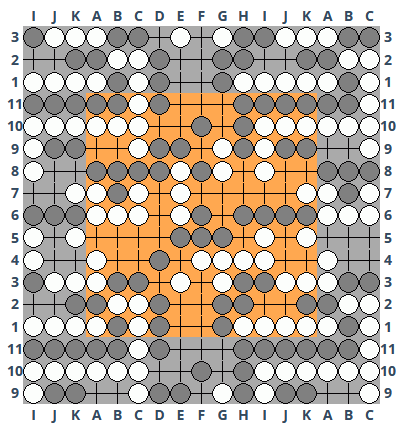Two-Headed Dragon
A Two-Headed Dragon (also known as Dragon Eats its Own Tail) is an unusual method of creating a living group. A Two-Headed Dragon is a group that has two eyes that are at first sight false eyes, nevertheless these two eyes are enough for living. To get this position, the group has to be a ring around some living group of an opponent, as in this diagram. Because the eyes are connected to each other in both directions, White cannot play at either of them first, and thus they function as real eyes, even though they have all the looks of false ones [1]. There does not seem to be a word for this sort of eye (apparently false, but actually real, due to connections in two directions). A group can live with one "normal" eye and another eye like this - see example 6 below.
Examples in tournament practice
In actual play, these positions are extremely rare but not non-existent.
In the final of the Japanese Ryusei tournament 2019, Ueno Asami fiercely attacked a big dragon of Ichiriki Ryo. He narrowly escaped by making life as a two-headed dragon and prevented Ueno from becoming the first female player to win an open (mixed gender) all-pro participating tournament in Japan. She was seventeen at the time.
You can download a ![[ext]](images/extlink.gif) game containing a two-headed dragon.
game containing a two-headed dragon.
Two other examples, one a game from the 20th World Amateur Championship and one a go problem, are ![[ext]](images/extlink.gif) located (dead link) on the GoGoD site.
located (dead link) on the GoGoD site.
Three examples from professional play are analyzed in the book Weird and Wonderful - Volume 1 - Extraordinary Moves by Professional Go Players.
More examples
This example is based on example 2, changing the colour of the marked stone.
Here only one of the black eyes, the one in the corner, is "unusual" (i.e., locally looks like a false eye). The other eye (the one next to the marked stone) is a "normal" one-space eye.
Example 7: from toroidal Go

Malcolm This sort of eye seems to me to be more common in (11x11) toroidal Go. This example is from one of my ![[ext]](images/extlink.gif) toroidal Go games. This picture shows the final position; Black has resigned. If Black were to continue playing this game, some variations have White connecting at J8 or J7, at which point A2 becomes a (seemingly false, but actually real) eye.
toroidal Go games. This picture shows the final position; Black has resigned. If Black were to continue playing this game, some variations have White connecting at J8 or J7, at which point A2 becomes a (seemingly false, but actually real) eye.
See also
- Eyes Collection
- Two Squares patterns
![[Diagram]](diagrams/49/504b176258bb69605690e2c37409cca1.png)
![[Diagram]](diagrams/2/8e6460e833dc35e934a93b5bade33d1d.png)
![[Diagram]](diagrams/42/dd247ebcca1391f86d9b5a22146ad256.png)
![[Diagram]](diagrams/2/9c8f5407f4ae0f979c53a1fd39209874.png)
![[Diagram]](diagrams/45/bec802560b572cdd41165899ebd62421.png)
![[Diagram]](diagrams/7/f5fe1075598c45c1f1a530e667d3fc36.png)
![Sensei's Library [Welcome to Sensei's Library!]](images/stone-hello.png)